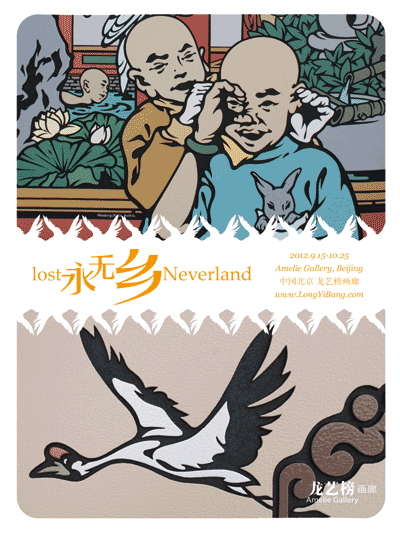Lost Neverland

Huang Kai is hopelessly lost in his obsession with the hutongs, those alleyways left over from the Chinese cities of old. In his studio, we saw the various alley signs he has "picked up" (read: stolen) over the years: #46 Carpet Hutong, #54 East Boulevard, #173-1 Porcelain Lane¡ These old rusty metal signs are about the size of a snuff box, red or blue. You can almost imagine Huang Kai's scrawny frame hovering about these deserted alleys, stealthily scurrying to and fro. He even once lugged a street sign as tall as a man back to his house in the middle of the night, worrying all the way that he would be stopped by a policeman. If the sign in your alley goes missing, you might want to ask Huang Kai if he's ever stopped by.
Under the shade of a hutong tree, a young Huang Kai took a jar of facial cream his mother had finished with, and filled it with stickers and glass marbles, he placed a red maple leaf on the top, then buried the jar under the roots of a tree, thinking that after a long time it would really turn into a treasure just like in the books. He never could wait very long though, and would always come back to dig it up and have a look before burying it again. This continued, over and over, until one day he forgot where he had buried it, and he never found it again. When Huang and his friends would get out of school, they wouldn't go home to do their homework but scurry down the concrete pipes in the construction site down in the alleys, writing their names on the sides of the pipes. His body was covered in bug bites, but he just kept laughing and playing. One day the concrete pipes were moved, and the kids stood there in the empty construction site, devastated. In the hutongs, the houses are all laid out one right next to the other, with their courtyards neatly packed with all kinds of things. In the big communal yards, the old folks would gather around in a circle to play mahjong and talk about their families. When parents got home from work, they would busy themselves cooking dinner and washing the laundry¡ All of this touched Huang Kai somewhere deep in his heart.
He wanted to use his painting and woodcuts to cling to "Tongjia Alley," "Suoluo Alley" and "Red Star Alley" from his childhood. In 2006, he was at the art academy working on his graduate thesis piece as Chinese New Year drew close. The night before the festivities, he attached the final draft of his printing board on the work table, not wanting to go home for the holiday. Since he wanted to continue working so badly, he couldn't sit still even at home, and he went back to the school only three days into the break. The campus was empty except for a guard wrapped in an army cloak, squatting by the main gate as he smoked his cigarettes. With the heat turned off for the holiday, the studio was freezing, so Huang Kai wore every bit of clothing he had as he worked away at the woodcut print. He was exhausted, so he sat down and took a good look at himself: they say that people have eight layers of skin; well, he had nine. When summer came, he stayed in the studio making works as the sweat rolled off his body, the rhythms of his work accompanied by the sounds of his classmates playing basketball outside the window. He clenched his teeth and said to himself: "Stick to it. This is your art!"
This time, Huang Kai has gotten some of his fun-loving friends together to present us with the Lost Neverland contemporary art exhibition at Amelie Gallery, bringing the audience to a childhood from which they'll never return. Liu Xiaoyong's paintings imagine an innocent little girl who loves to fish and catch shrimp by the river, forgetting to go home through all the fun as a bird builds a nest in her hair. Her works are marked by a surrealist sense of illusion, with babies hidden inside clamshells, a frog hogging the microphone and a cuttlefish spurting fountains of water. Her paintings are wild like a Hayao Miyazaki film, with equally bizarre characters. Liu Jiajia likes to play with wood. She uses different textured woods (such as mahogany, ebony, green sandalwood, sathon wood and teak) to carve such figures as a dog with its tongue sticking out, a fat monkey with a rooster tail or a shy little girl standing under a tree. They have the charming naivety and mischievousness of a fairytale. Then there is Yang Huining, who loves to paint birds, draping phoenixes, peacocks and swans with luxuriant adornments, drawing from ancient Chinese garden paintings, murals and ceiling paintings for the patterns, and creating lush but simple colors from mineral pigments in a salute to the glorious traditions of classical Chinese decorative art. Ma Kai reflects her childhood toys in glittering shards of glass, creating exquisite lithographs with a sandblasted texture that matches the nostalgic theme¡ Their works are commendable for their sincerity, their mediums and creative approaches brimming with eccentric inspiration. There is no attempt to deliberately mystify or take on academic airs, just freewheeling odes to our lost childhood.

 Tel:
Tel: Address:
Address: Email:
Email: Hours:
Hours: